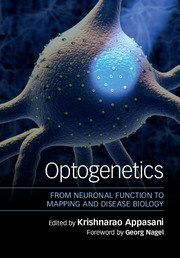Book contents
- OptogeneticsFrom Neuronal Function to Mapping and Disease Biology
- Optogenetics
- Copyright page
- Dedication
- Contents
- Contributors
- Foreword
- Preface
- Part I Optogenetics in Model Organisms
- Part II Opsin Biology, Tools, and Technology Platform
- Part III Optogenetics in Neurobiology, Brain Circuits, and Plasticity
- Part IV Optogenetics in Learning, Neuropsychiatric Diseases, and Behavior
- 17 Optogenetics to Study Reward Learning and Addiction
- 18 Optogenetics and the Dissection of Neural Circuits Underlying Depression and Substance-use Disorders
- 19 Optogenetics Research in Behavioral Neuroscience: Insights into the Brain Basis of Reward Learning and Goal-directed Behavior
- 20 Toward an Optogenetic Therapy for Epilepsy
- 21 Using Optogenetics and Stem Cell-derived Neural Engraftment Techniques to Restore Lost Motor Function
- Part V Optogenetics in Vision Restoration and Memory
- Part VI Optogenetics in Sleep, Prosthetics, and Epigenetics of Neurodegenerative Diseases
- Index
- Plate Section (PDF Only)
- References
19 - Optogenetics Research in Behavioral Neuroscience: Insights into the Brain Basis of Reward Learning and Goal-directed Behavior
from Part IV - Optogenetics in Learning, Neuropsychiatric Diseases, and Behavior
Published online by Cambridge University Press: 28 April 2017
- OptogeneticsFrom Neuronal Function to Mapping and Disease Biology
- Optogenetics
- Copyright page
- Dedication
- Contents
- Contributors
- Foreword
- Preface
- Part I Optogenetics in Model Organisms
- Part II Opsin Biology, Tools, and Technology Platform
- Part III Optogenetics in Neurobiology, Brain Circuits, and Plasticity
- Part IV Optogenetics in Learning, Neuropsychiatric Diseases, and Behavior
- 17 Optogenetics to Study Reward Learning and Addiction
- 18 Optogenetics and the Dissection of Neural Circuits Underlying Depression and Substance-use Disorders
- 19 Optogenetics Research in Behavioral Neuroscience: Insights into the Brain Basis of Reward Learning and Goal-directed Behavior
- 20 Toward an Optogenetic Therapy for Epilepsy
- 21 Using Optogenetics and Stem Cell-derived Neural Engraftment Techniques to Restore Lost Motor Function
- Part V Optogenetics in Vision Restoration and Memory
- Part VI Optogenetics in Sleep, Prosthetics, and Epigenetics of Neurodegenerative Diseases
- Index
- Plate Section (PDF Only)
- References
- Type
- Chapter
- Information
- OptogeneticsFrom Neuronal Function to Mapping and Disease Biology, pp. 276 - 291Publisher: Cambridge University PressPrint publication year: 2017



